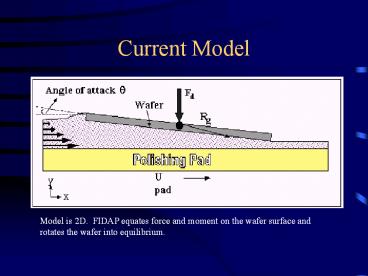Current%20Model PowerPoint PPT Presentation
Title: Current%20Model
1
Current Model
Model is 2D. FIDAP equates force and moment on
the wafer surface and rotates the wafer into
equilibrium.
2
Comparison with Experimental Results
- Model predictions compared with fluid film
thickness and pitch angle results from Lu et al
(2001) - Results on same order
- Film thickness differs by constant of about 20 ?m
- difference due to DELIF technique? - Angle of attack is on same order as
experimentally measured value
42
Tufts University Dept. of Mechanical
Engineering MS Thesis Defense Oct 17, 2002
3
Adding Material Removal
- A method to determine removal rate must be
determined. - Possible models include
- Modified Prestons law
- Surface stress model
- Abrasive and chemical wear model
- Arbitrary user-defined model
4
RR Models
- A modified Preston model is probably best.
- Should provide flexibility for various problem
types. - Easiest way to obtain removal rate on global
scale. - Current research on Preston coefficients for CMP
exists to some degree. - Options could become limited depending on the
method used in FIDAP to implement removal rate of
the wafer.
5
Current Work Computer Set-up
- Current version of FIDAP (8.7) is not compatible
with the existing models created in the earlier
version FIDAP (8.52), although it should be. - Converting model databases and subroutines this
month. - Currently trying to working with FIDAP technical
support to remedy FORTRAN compiler issues on new
university UNIX server.
6
Project Priorities Material Removal or Pad
Deformation?
- Should we pursue pad deformation modeling in lieu
of removal rate? - If pad deformation experimental envelope and
simulations should be coordinated
7
Initial Strategies for Pad Deformation Model
- Two existing FIDAP approaches
- Model pad as a flexible thin film
elasticity(vein wall example) boundary
condition to fluid problem - Rigid body movement full model of pad
- First approach is more compatible with previous
modeling efforts - Currently running simpler test cases with
standard FIDAP model while compiler problem is
upgraded
PowerShow.com is a leading presentation sharing website. It has millions of presentations already uploaded and available with 1,000s more being uploaded by its users every day. Whatever your area of interest, here you’ll be able to find and view presentations you’ll love and possibly download. And, best of all, it is completely free and easy to use.
You might even have a presentation you’d like to share with others. If so, just upload it to PowerShow.com. We’ll convert it to an HTML5 slideshow that includes all the media types you’ve already added: audio, video, music, pictures, animations and transition effects. Then you can share it with your target audience as well as PowerShow.com’s millions of monthly visitors. And, again, it’s all free.
About the Developers
PowerShow.com is brought to you by CrystalGraphics, the award-winning developer and market-leading publisher of rich-media enhancement products for presentations. Our product offerings include millions of PowerPoint templates, diagrams, animated 3D characters and more.

